How to Grow Broccoli Sprouts: Easy Methods
- February 19, 2024
- 0 comment
Broccoli sprouts have gained popularity due to their high levels of sulforaphane, a compound with potential health benefits. Growing broccoli sprouts at home is a simple and rewarding process. This guide will walk you through the steps to cultivate these nutritious sprouts right in your kitchen.
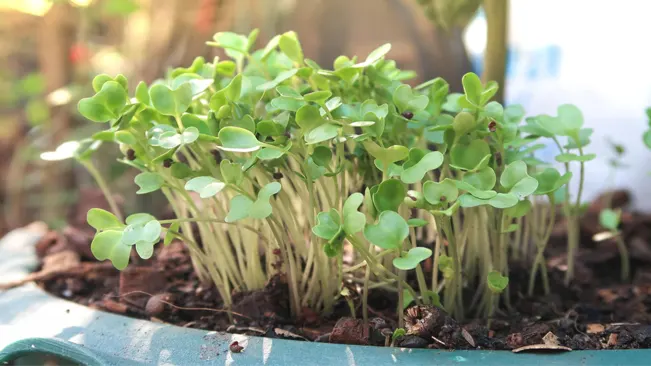
| Benefit | Description |
|---|---|
| High in Sulforaphane | Contains high levels of sulforaphane, a powerful compound known for its antioxidant properties and potential cancer-fighting capabilities. |
| Antioxidant Properties | Rich in antioxidants which help reduce oxidative stress and may lower the risk of chronic diseases. |
| Supports Heart Health | May improve heart health by reducing inflammation, cholesterol levels, and blood pressure. |
| Aids in Digestion | High fiber content supports healthy digestion and gut health. |
| Boosts Immune System | Contains compounds that may enhance the immune system’s ability to fight off infections. |
| Detoxification | Sulforaphane is believed to aid in detoxification processes in the body, helping to eliminate harmful toxins. |
| Anti-Inflammatory Effects | Exhibits anti-inflammatory properties, potentially beneficial for conditions like arthritis and other inflammatory diseases. |
| Promotes Skin Health | Antioxidants and other nutrients in broccoli sprouts may contribute to healthier skin and protection against UV radiation. |
| Supports Brain Health | The nutrients in broccoli sprouts, including sulforaphane, might support brain health and cognitive function. |
| Potentially Reduces Cancer Risk | Sulforaphane and other phytochemicals present in broccoli sprouts have been studied for their potential role in reducing the risk of various cancers. |
Seed Selection
Start by choosing high-quality, organic broccoli seeds that are specifically labeled for sprouting. This ensures they are free from harmful chemicals.
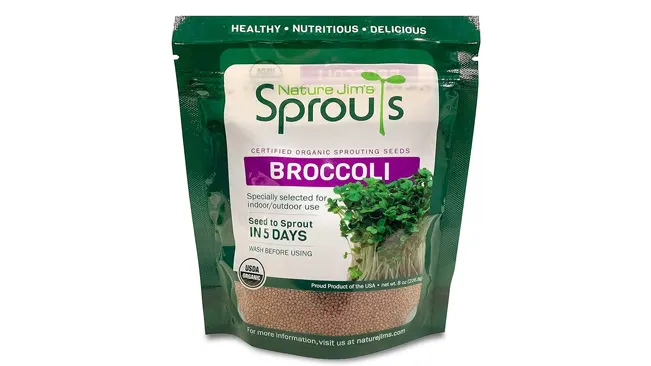
High-Quality Seeds
- Purity: Look for seeds that have a high germination rate, which is a sign of their quality. This ensures that most of the seeds you plant will sprout.
- Freshness: Fresh seeds are more likely to germinate effectively. Check the packaging date or best-before date to ensure freshness.
Organic Certification
- No Harmful Chemicals: Organic seeds are grown without the use of synthetic pesticides and fertilizers. This is especially important for sprouts, as they are eaten raw and these chemicals can be harmful to your health.
- Safety Standards: Organic certification means the seeds have been produced following certain safety standards. This gives an added assurance of the quality and safety of the seeds.
Specifically Labeled for Sprouting
- Safety for Consumption: Seeds meant for sprouting are handled and processed with the intention of being consumed raw. This is different from seeds meant for garden planting, which might be treated with fungicides or other chemicals not intended for human consumption.
- Reduced Risk of Contamination: Seeds specifically for sprouting are often tested for harmful bacteria like Salmonella or E. coli, which are particularly concerning for sprouts as they are ideal environments for these bacteria to grow.
Reputable Source
- Reliable Suppliers: Purchase seeds from reputable suppliers or brands that specialize in seeds for sprouting. They are more likely to have strict quality control measures.
- Reviews and Recommendations: Look for reviews or ask for recommendations from experienced sprouters to find the best sources for sprouting seeds.
Avoiding Treated Seeds
- Check for Labels: Some seeds are treated with chemicals to enhance growth or protect them from pests when planted in soil. Avoid these for sprouting as these chemicals can be harmful when ingested.
Variety Selection
Flavor and Nutritional Profile: There are different varieties of broccoli seeds available, each with subtle differences in flavor and potentially in their nutritional profile. You may want to experiment with different varieties to find your preference.
Calabrese Broccoli
This is the most common variety, often simply referred to as “broccoli”. It has large green heads and thick stalks, and it’s named after the Italian province of Calabria.
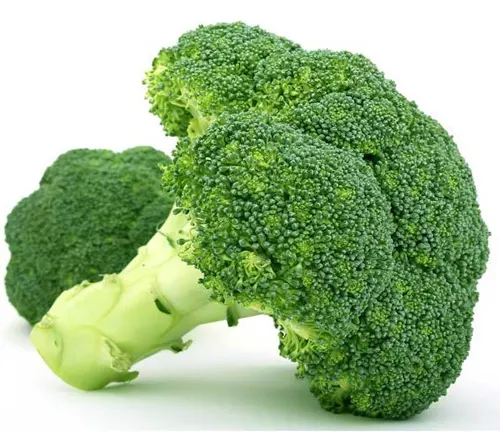
Sprouting Broccoli (Broccolini)
A hybrid between broccoli and Chinese broccoli (Gai Lan). It has long, thin stalks and small florets, and it’s milder and sweeter than regular broccoli.

Romanesco Broccoli
Known for its striking appearance with a fractal pattern and chartreuse color. It has a milder, nuttier flavor compared to traditional broccoli.

Purple Sprouting Broccoli
This variety is hardier and has beautiful purple florets. It’s more tolerant to cold weather and has a slightly different flavor profile, being sweeter and more tender.
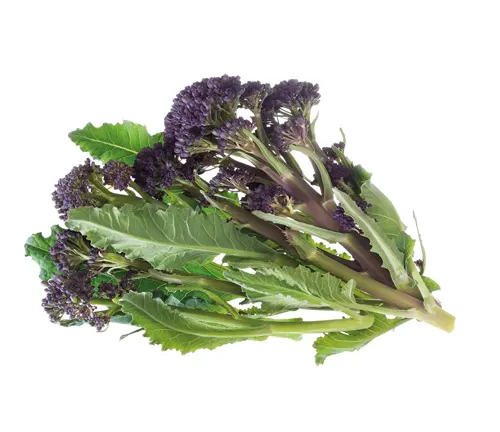
Chinese Broccoli (Gai Lan)
Although technically a different species, it’s closely related to broccoli. It has thick, flat leaves and small florets, with a more bitter and earthy taste.
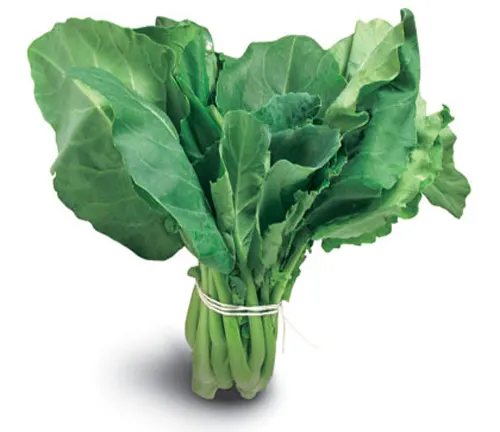
Broccoli Raab (Rapini)
Another close relative of broccoli, this variety has more leafy greens and smaller florets. It has a more pungent and bitter flavor, which is popular in Italian and Portuguese cuisines.
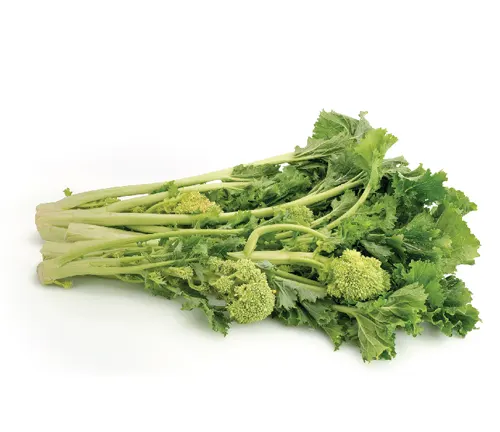
Belstar Broccoli
A robust hybrid variety that is particularly suited for organic growing. It produces large, tight heads and can perform well in a variety of climates.
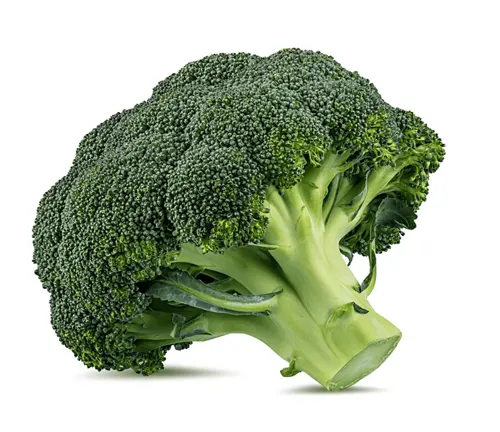
Di Cicco
An Italian heirloom variety that produces smaller, more numerous heads and can be harvested multiple times throughout the growing season.
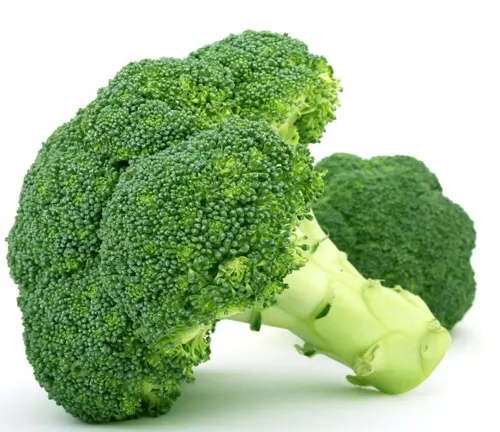
Waltham 29
Known for its cold tolerance, this variety is a great option for fall planting. It produces medium to large heads and is a popular choice for home gardens.
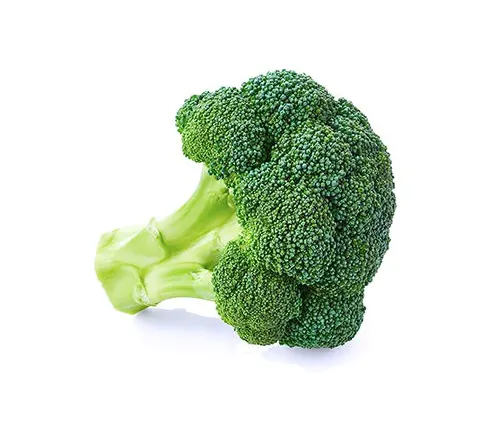
Green Goliath
Aptly named for its large heads and thick, meaty stalks. This variety is known for its good flavor and ability to produce side shoots for continued harvest.
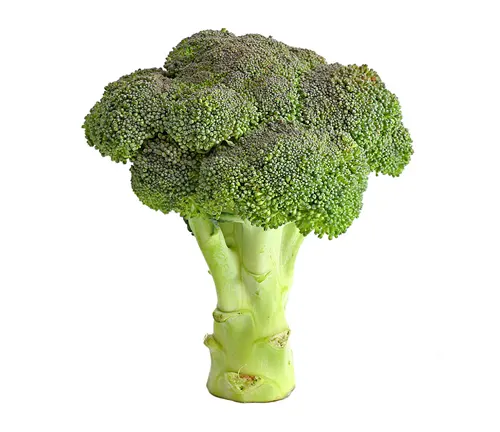
Preparation
Measuring the Seeds
- Start by measuring out 1-2 tablespoons of broccoli seeds. This quantity is sufficient for a batch that will grow enough sprouts for a few servings.
- The amount can be adjusted based on the size of your sprouting jar or tray. A general rule is that the seeds should cover the bottom of your container in a single layer.
Rinsing the Seeds

- Place the measured seeds in a fine-mesh sieve or a bowl.
Run cold water over the seeds. This step is important for a couple of reasons: - Removing Impurities: Seeds, even those packaged for sprouting, can have tiny bits of debris, dust, or other impurities from the packaging or during handling. Rinsing helps to clean them off.
- Hydrating the Seeds: This initial rinse also starts the process of rehydrating the seeds, which is necessary for germination. Seeds are dormant and dry, and exposing them to moisture begins their awakening process.
Gently agitate the seeds with your hand or a spoon while rinsing to ensure all surfaces are cleaned. Be sure to use cold water as warm or hot water might damage the seeds or initiate premature germination.
Checking for Damaged Seeds
- After rinsing, it’s a good practice to inspect the seeds and remove any that are broken or look unhealthy. Damaged seeds might not germinate properly and can potentially lead to mold growth.
Draining the Seeds
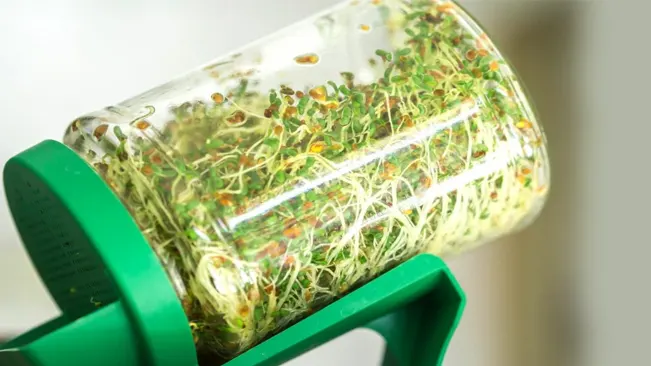
- After rinsing, allow the seeds to drain thoroughly. You can leave them in the sieve or mesh strainer for a few minutes to let excess water drip off.
- Ensuring the seeds are not waterlogged is important to prevent mold growth during the sprouting process.
Starting the Soaking Process
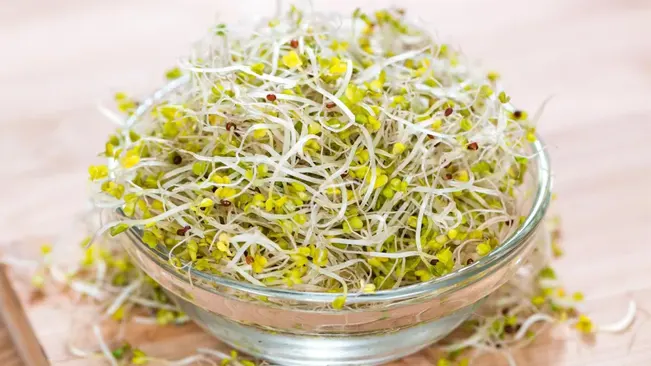
- After the initial rinse and drain, the seeds are ready to be soaked. This step, typically done in a jar or sprouting container, involves submerging the seeds in water for 8-12 hours. It is a crucial step that kickstarts the germination process.
Germination
Germination is a critical phase in the growth of any plant, including broccoli sprouts. Here’s a detailed explanation of what happens during germination and why certain steps, like placing the sprouts in a warm, dark place and rinsing them regularly, are important:
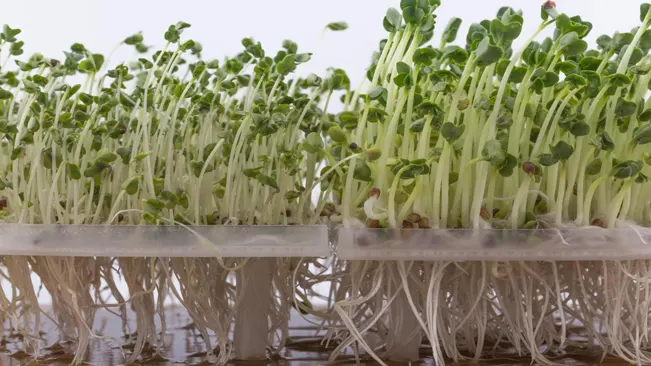
Understanding Germination in Broccoli Sprouts
- Initiation of Germination:
- Germination begins once the seeds are soaked in water. This soaking process breaks the seed’s dormancy and triggers the awakening of the embryo inside the seed.
- Water absorption by the seed activates enzymes that start the process of growth.
- Warmth and Darkness:
- The seeds require a warm and dark environment for optimal germination. This mimics the natural soil conditions where seeds generally sprout.
- Warmth aids in speeding up the enzymatic activities that are essential for sprout growth.
- Darkness helps in concentrating the plant’s energy on the germination process rather than on photosynthesis, which is not needed at this stage.
- Rinsing and Draining:
- Rinsing the sprouts 2-3 times a day is crucial. It keeps the seeds moist, ensuring they have enough water for the germination process.
- Regular rinsing also helps in removing metabolic waste products that can accumulate around the seeds, which might otherwise impede growth or encourage mold and bacterial growth.
- Proper draining is equally important. Excess water can create a breeding ground for mold and bacteria, potentially spoiling the sprouts. The aim is to keep the seeds moist but not waterlogged.
The Process of Sprout Development
Radicle Emergence
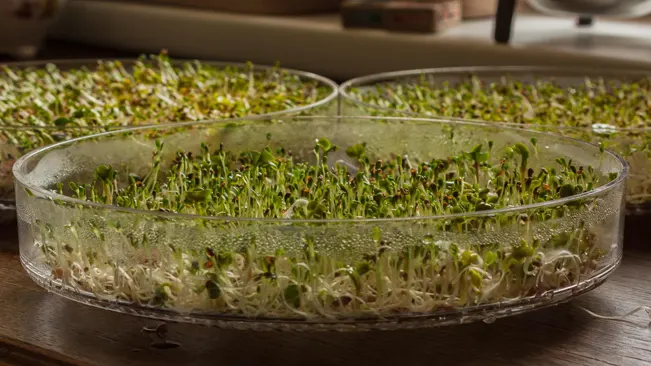
- The first sign of germination is the emergence of the radicle, the embryonic root. This root starts to absorb nutrients and water.
- Once the radicle emerges, the plant begins to expend stored energy within the seed to grow rapidly.
Shoot Development
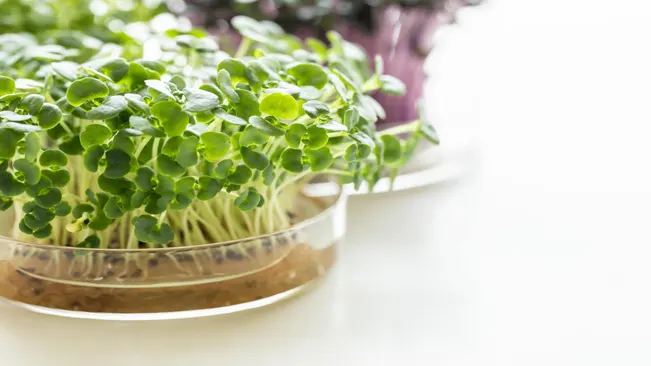
- Following the emergence of the root, the shoot starts to develop and grow upwards.
- In the case of broccoli sprouts, the shoot will eventually develop into the green parts we consume.
Transition to Light

- Once the sprouts have grown to a certain stage (usually visible by the growth of tiny leaves), they require light to begin photosynthesis.
- The transition from a dark environment to light is a delicate process. Initially, indirect light is sufficient and helps the sprouts to develop chlorophyll, giving them their green color.
Maturity and Harvest
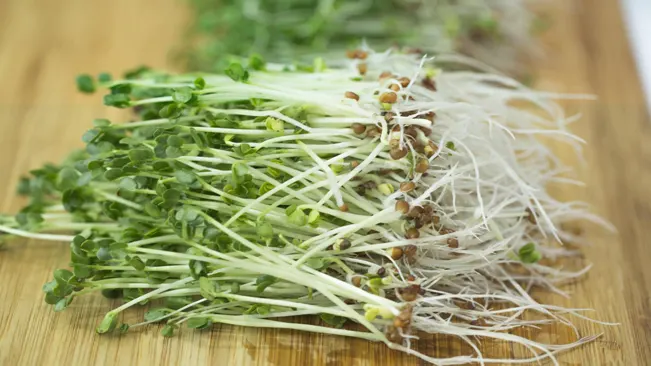
- The sprouts are typically ready to harvest when they are about 1-2 inches tall and have green leaves. This usually takes about 5-7 days from the start of germination.
- At this stage, the sprouts are packed with nutrients and are ready for consumption.
Storage and Usage
Store your broccoli sprouts in a sealed container in the refrigerator. They typically stay fresh for about a week. Enjoy your homegrown sprouts in salads, sandwiches, or as a garnish on your favorite dishes.
Storage
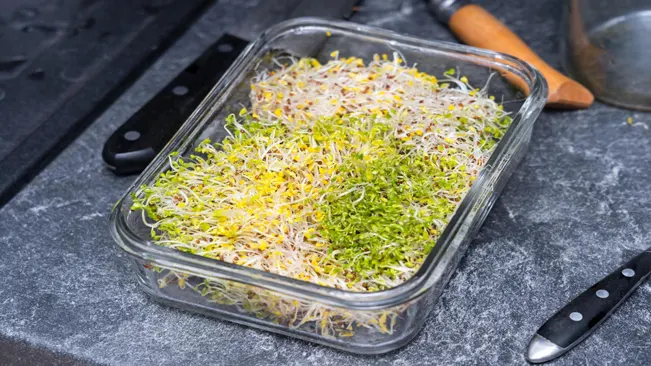
- Proper Sealing: After harvesting the broccoli sprouts, it’s crucial to store them in a tightly sealed container. This prevents moisture from escaping and keeps the sprouts fresher for longer.
- Refrigeration: Broccoli sprouts should be stored in the refrigerator. The cool temperature slows down the deterioration process and helps maintain their crispness and nutritional value.
- Avoiding Excess Moisture: Ensure the sprouts are reasonably dry before storing them. Excess moisture can lead to mold growth. However, they shouldn’t be completely dry; a bit of moisture is necessary to keep them alive.
- Check Regularly: Keep an eye on your sprouts during storage. If you notice any that look slimy or have a foul smell, discard them immediately to prevent them from affecting the others.
- Shelf Life: Generally, broccoli sprouts will last about a week in the refrigerator, but it’s best to consume them as soon as possible for optimal freshness and nutritional value.
Usage
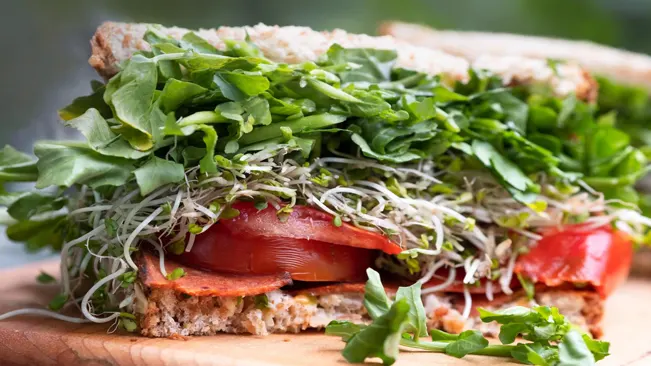
- Rinsing Before Use: Always rinse broccoli sprouts under cold water before using them. This removes any residual dirt or bacteria.
- Raw Consumption: Broccoli sprouts are most beneficial when eaten raw, as cooking can reduce their nutritional content, particularly the sulforaphane levels.
- Incorporation in Meals:
- Salads: Add a crunchy, nutritious punch to your salads by sprinkling a handful of broccoli sprouts on top.
- Sandwiches and Wraps: Incorporate sprouts into sandwiches and wraps for an added texture and a boost of nutrients.
- Smoothies: For a healthful twist, you can blend broccoli sprouts into smoothies. Their mild flavor is easily masked by fruits and other ingredients.
- Garnishes: Use them as a garnish on soups, stews, or any dish where you’d like a bit of extra crunch and nutrients.
- Snacks: Combine them with other vegetables for a healthy, raw snack.
- Portioning: Since broccoli sprouts are highly nutritious, a small amount can provide a significant health boost. There’s no need to overdo it; a handful per serving is typically sufficient.
- Caution for Certain Individuals: While broccoli sprouts are generally safe, individuals with thyroid issues or those who are pregnant should consult with a healthcare provider before consuming them in large quantities.
Conclusion
Growing broccoli sprouts at home is an easy and enjoyable way to add a nutritious boost to your diet. By following these simple steps, you’ll have a continuous supply of fresh sprouts packed with health benefits.
FAQs (Frequently Asked Questions)
- What are the best conditions for sprouting broccoli seeds?
Broccoli seeds sprout best in a warm (around 70°F or 21°C), dark environment for the initial germination phase, followed by exposure to indirect light to develop chlorophyll. - How much water do I need to use for soaking the seeds?
Use enough water to fully submerge the seeds, typically about two inches above the level of the seeds in a jar or tray. - How often should I rinse the broccoli sprouts?
Rinse the sprouts 2-3 times a day during the germination phase to keep them moist and prevent mold growth. - Can I use any type of broccoli seeds for sprouting?
It’s recommended to use seeds specifically labeled for sprouting, as they are tested for pathogens and are safe for consumption when eaten raw. - How long does it take for broccoli sprouts to be ready to eat?
Broccoli sprouts usually take about 5-7 days from soaking to reach a harvestable size. - How do I know if my sprouts have gone bad?
Bad sprouts may have a foul smell, slimy texture, or visible mold. If you notice any of these signs, it’s best to discard them. - Do I need to use any fertilizers or growth enhancers?
No, broccoli sprouts do not require fertilizers or growth enhancers. They will grow well with just water and proper care. - Can I grow broccoli sprouts in any container?
You can use a special sprouting jar or tray, or any clean glass jar. If using a jar, cover it with cheesecloth or a similar breathable material secured with a rubber band. - How can I prevent mold from growing on my broccoli sprouts?
Ensure thorough drainage after each rinse, maintain good air circulation, and avoid overcrowding the seeds in the container to prevent mold growth. - Are there any health risks associated with eating homegrown broccoli sprouts?
If grown and handled properly, there are minimal risks. However, it’s essential to use seeds meant for sprouting and maintain cleanliness to avoid bacterial contamination. Pregnant women, young children, the elderly, and individuals with compromised immune systems should consult with a healthcare provider before consuming raw sprouts.

Kristine Moore
Forestry AuthorI'm Kristine Moore, a seasoned garden landscaping professional with over 30 years of experience. My extensive career has been dedicated to transforming outdoor spaces into stunning, sustainable landscapes. With a deep understanding of horticulture, design principles, and environmental stewardship, I have become a respected figure in the field, known for creating harmonious, visually appealing, and eco-friendly gardens. My commitment to excellence and continuous learning in landscaping trends and techniques has solidified my reputation as an expert in garden design and implementation.


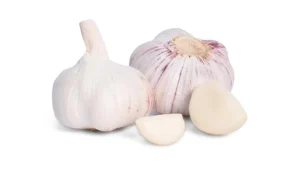
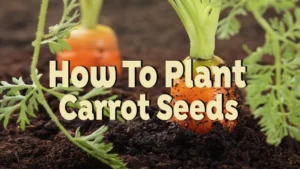




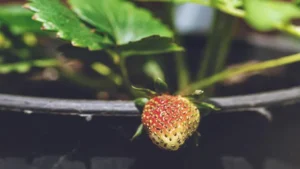



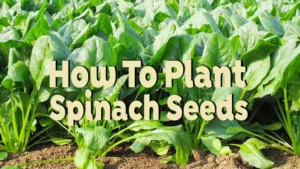
Leave your comment